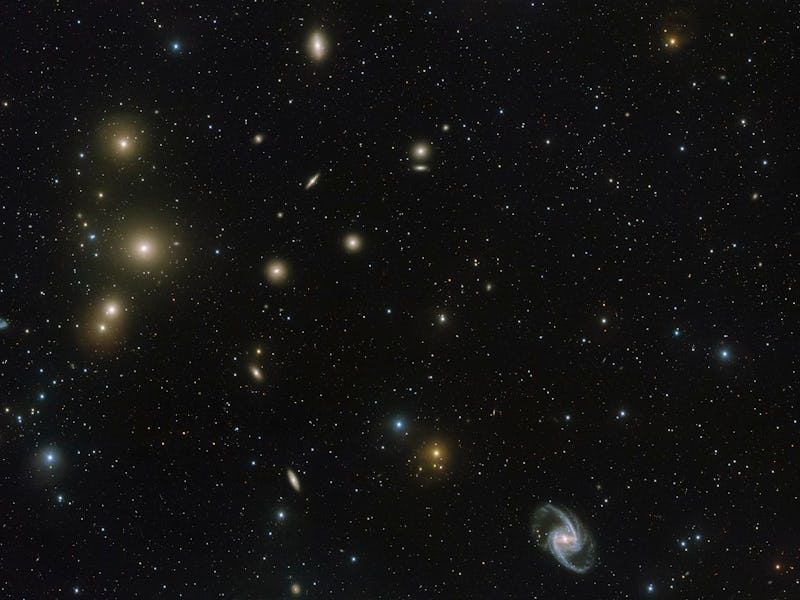Groundbreaking New Photos of the Fornax Cluster Reveals a Cannibal Galaxy
The "galactic cannibal" NGC 1399 swallows up neighboring galaxies whole.

In a cluster of galaxies about 62 million light-years away, a galactic cannibal is lurking: New images of the Fornax Cluster — a.k.a. “The Furnace” — snapped in wide scope by the VLT Survey Telescope in Chile revealed the scattering of almost 60 large galaxies throughout the cluster and the massive galaxy at its center, sucking in everything around it.
Publishing her team’s findings today in Astrophysical Journal, the study’s lead author Enrica Iodice, Ph.D., told Inverse that the ongoing cannibalism at the center of Fornax is a physical process that depends on the tides of each galaxy’s gravitational forces. In the end, she says, “the stronger fighter wins.”
The Fornax cluster, the second-closest galaxy cluster to Earth, is one of the best-studied, but it hasn’t been easy to capture in its entirety. The new images captured using the VLT Survey Telescope allowed Iodice’s team to put together a mosaic of images, revealing the overall distribution of the galaxies in the cluster out to its very edges. It was at the center of the Furnace — at the left of the mosaic image — that they noticed the cannibal galaxy NGC 1399 swallowing the smaller galaxies around it.
The cD galaxy NGC 1399, at left, is a galactic cannibal, sucking in smaller galaxies around it.
“The cD galaxy at the center of a cluster (such as NGC 1399 in Fornax) is a very massive object,” Iodice says, explaining that its strong gravitational pull attracts smaller neighboring galaxies toward its center. While it’s too faint to show up in the Fornax image, there’s a blue bridge of light that exists between the cannibal and its closest neighbor, NGC 1387. It’s made up of stars, created in the gas being pulled from the neighboring galaxy by the gravitational pull of NGC 1399.
The cannibal is a hungry one, Iodice explains: “This merging process ends when the “fuel” runs out, namely when there are no more systems to be eaten and the cluster is changed into a supergalaxy.”
This wide-field view of the Fornax Galaxy Cluster was pieced together by images from Chile's VLT Survey Telescope
Among the other surprises uncovered by the new snapshots of the Fornax galaxy are the large barred spiral galaxy NGC 1365, near the bottom right of the image, which contains a supermassive black hole in its center.
Above all, the Fornax cluster illustrates the immense power of gravity. Keep in mind that the Fornax is a cluster of almost 60 large galaxies — entities like the Milky Way, which alone claims up to 100 billion solar systems — being pulled together by the gravity from large amounts of dark matter and the galaxies themselves.
It’s not always easy to define where such an immense cluster begins or ends in the vastness of space, but Iodice explains that in many ways, it helps to think of Fornax as a city with galaxies for houses.
“They are there where the decrease of the number of dwellings per unit surface, which is maximum at the center, flattens out at the average value of the intercity space,” she says. The only difference is that terrestrial cities don’t have galactic cannibalistic forces sucking houses into the downtown core.
A bird soaring over the remote, sparsely populated Atacama Desert in northern Chile, possibly the driest desert in the world, might be surprised to come upon the technological oasis of ESO's Very Large Telescope (VLT) at Paranal.